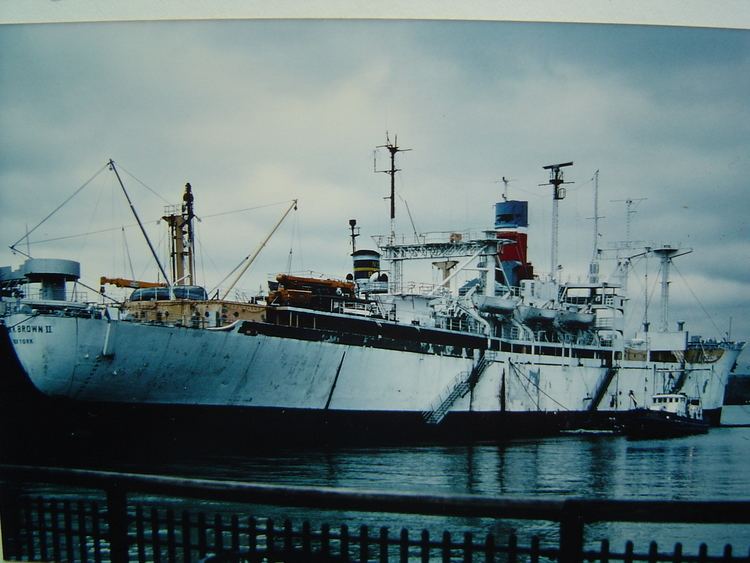Name SS Twin Falls Victory Owner Maritime Commission Construction started 27 December 1944 Length 139 m | Namesake Twin Falls, Idaho Laid down 27 December 1944 Launched 6 February 1945 Displacement 7.267 million kg | |
 | ||
Operator Pope & Talbot Incorporated Ordered As victory ship MCV Hull 167 Builder Oregon Shipbuilding Corporation | ||
SS Twin Falls Victory, named after Twin Falls, Idaho, was a Victory ship built for World War II. Converted to a Missile Range Instrumentation Ship, she was initially operated by the US Air Force as USAF Twin Falls Victory, before coming under US Navy control and being named USNS Twin Falls (T-AGM-11/T-AGS-37). She later had a third career as the training ship SS John W. Brown II.
Contents
History
Twin Falls Victory was laid down under a Maritime Commission contract (MCV hull 167) on 27 December 1944 at Portland, Oregon, by the Oregon Shipbuilding Corporation; launched on 6 February 1945; sponsored by Mrs. J. B. Pfietor; and delivered to Pope & Talbot, Inc., of Portland, Oreg., the first of several companies to operate her under contract with the War Shipping Administration.
Korean War
From 1950 - 1953, Twin Falls Victory was operated by States Marine Corporation. During the Korean War she participated in the Inchon Landings and Hungnam Evacuation, making her merchant marine crew eligible for the Korean Service Medal and the United Nations Service Medal. By April 1958, she was out of service and laid up with the National Defense Reserve Fleet at its berthing area on the James River in Virginia.
Missile range instrumentation ship
On 24 March 1960 Twin Falls Victory was withdrawn from James River and delivered to the Air Force. She was converted to a missile range instrumentation ship and served as part of the Eastern Test Range. The U.S.Army had funded the purchase under the Pershing Missile Project for the Atlantic Missile Range to prove the aiming accuracy of the Pershing missile. The ship was modified by equipping it with special navigation systems, AN/FPS-16 monopulse missile tracking radar, telemetry receiving equipment, AN/SPN-8 splash detection radar, AN/GMD-1A Rawinsonde tracking equipment and a balloon hangar, to house a Kytoon tethered blimp and as a weather balloon inflation shelter. The ship eventually was delivered to the Atlantic Missile Range and operated by merchant marine crewmen and contractor technical staff. Pan American World Airways and its subcontractor RCA MTP operated the radar, telemetry, navigation and weather instrumentation aboard the ship. The ship was operated under the name USAF Twin Falls Victory until turned over to MSTS on 1 July 1964 at which time the ship was redesignated T-AGM-11 Twin Falls and continued to serve as a mobile tracking platform for recording data on missiles and satellites that were out of range of land-based tracking stations.
On 15 May 1963, she was positioned approximately 350 miles (560 km) ESE of Savannah, Georgia (near 31°03′N 75°00′W) as part of Project Mercury, to track Gordon Cooper's extended MA-9 mission.
In October 1969, the Air Force determined that Twin Falls was no longer necessary to its mission. Placed in custody of the Maritime Administration (MARAD) on 22 May 1970, she was slated for disposal. On 26 April 1971, the Navy recalled her for "possible use as a survey ship". Presumably this was when she was redesignated T-AGS-37. Her name was struck from the Naval Vessel Register on 6 November 1972.
Training ship
Ex-Twin Falls was returned to MARAD on 2 November for "simultaneous transfer" to the New York City Board of Education on 6 November. Renamed SS John W. Brown II, she served as a training facility for that city's Food and Maritime Trade High School. She was returned to MARAD on 8 June 1982.
Fate
Twin Falls was withdrawn from MARAD on 30 June 1982 by Union Minerals & Alloys Corporation. She was scrapped in 1983. Her builders plate remains in MARAD's artifact collection.
